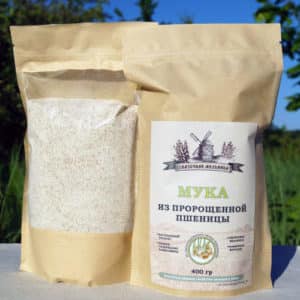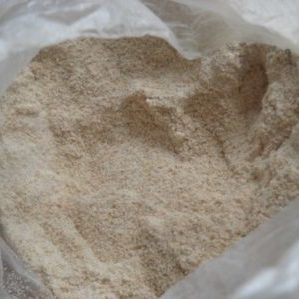What are the benefits of sprouted wheat flour, how to make it correctly and where to use it
Sprout flour wheat - a healthy dietary product. When germinated, the grain undergoes changes and becomes more valuable in its vitamin and mineral composition. Therefore, flour from it is used not only as a food product, but also for therapeutic and prophylactic purposes.
What kind of flour is this and why is it good?
Ordinary wheat flour has virtually no benefits for the body. The grain contains valuable components, but they are “preserved” and are not completely absorbed by the body. When placed in a humid environment, grains begin to germinate, antinutrients that interfere with the absorption of nutrients are partially destroyed, and beneficial compounds are activated.
Flour from sprouted wheat It has a high nutritional value, like the sprouts themselves, and supplies the body with protein, vitamins and minerals.

Composition and properties
Nutritional and energy value of flour per 100 g:
- 300 calories;
- 12 g proteins;
- 2 g fat;
- 62 g carbohydrates;
- 2 g dietary fiber.
Vitamins per 100 g:
- B1 - 0.3 mg (20% of the daily value);
- B2 - 0.2 mg (11%);
- B5 - 1.4 mg (28%);
- B6 - 0.4 mg (20%);
- B9 - 55 mcg (14%);
- PP - 4 mg (20%).
Minerals per 100 g:
- potassium - 220 mg (8.8%);
- calcium - 40 mg (4%);
- magnesium - 110 mg (28%);
- phosphorus - 280 mg (35%);
- iron - 3 mg (17%);
- manganese - 2.6 mg (130%);
- copper - 380 mcg (38%);
- selenium - 58 mcg (106%);
- zinc - 3.8 mg (32%).
Wheat germ flour is considered as a complete biologically active food supplement: all valuable substances are in a bioavailable form, are maximally absorbed in the gastrointestinal tract and have a complex positive effect on the body.
Benefits and harms
Beneficial properties of the product for the body:
- prevents diseases of the gastrointestinal tract;
- accelerates the course of chemical processes;

- improves blood quality;
- prevents the development of anemia;
- removes toxic compounds from the body;
- improves liver function;
- promotes the development of beneficial microflora in the intestines;
- has a positive effect on the hormonal system of men and women;
- replenishes the deficiency of minerals and vitamins due to poor and inadequate nutrition.
A product made from sprouts is useful for schoolchildren: it helps to cope with increased mental and physical stress. Regular consumption of dishes made from such flour increases children's immunity and accelerates intellectual development.
Advice. The product makes dishes more satisfying due to its nutritional density. Therefore, despite its high calorie content, it is indicated for use during weight loss.
Sprout flour is especially useful for older people:
- strengthens the heart;
- prevents cardiovascular diseases, including hypertension;
- improves vision;
- stimulates digestion, prevents constipation and heartburn;
- prevents the loss of muscle tissue;
- has a positive effect on the condition of the skin and bones;
- stimulates mental activity, improves memory;
- prevents arthritis.
In some cases, the product can cause harm to the body:
- Overeating leads to excess weight.
- In combination with dairy products it provokes severe flatulence.
- If improperly stored, mold develops in grain and flour. Fungi have a toxic effect on the body and cause a severe allergic reaction.
Contraindications
Sprout flour cannot be consumed if there are limiting factors:
- gluten and lectin intolerance;
- exacerbation of chronic diseases of the gastrointestinal tract and kidneys;
- recent surgical operations.
How to germinate wheat
You don't need any special equipment to germinate wheat. Main stages:
- The grains are sorted, damaged and spoiled, and debris are removed.
- Wash the raw materials under running cold water.
- Place in a glass jar and fill with water at room temperature. Remove floating grains - they will not germinate.
- Disinfect the product in a weak solution of potassium permanganate and then wash it in a large amount of water.
- Place in a glass jar and fill with water so that it slightly covers the grains.
- Cover the container with clean gauze folded in several layers.
- Leave on the table, away from direct sunlight.
- After 8–12 hours, the raw materials are washed under running water.
- Place wet wheat in a deep plate or container and distribute evenly. Layer thickness - no more than 2 cm.
- Cover with a damp cotton cloth folded in several layers.
- Leave under a damp cloth for germination for 8–10 hours. Periodically moisten it with a spray bottle.
As a rule, grains germinate unevenly - over the same period of time, some acquire long shoots, while others only manage to hatch.
Attention! Do not wait until the sprouts reach a length of 1 cm or more. 1–3 mm is enough.
After germination, the raw materials are sorted, removing specimens with sprouts larger than 3 mm - they worsen the taste of baked goods and are more suitable as a dietary supplement.
How to make flour

Manufacturing stages:
- The grain is evenly distributed in a thin layer on a baking sheet or electric dryer pads.
- Dry at +40°C for 2-3 hours. The oven is set to convection mode.
- Cool the raw material to room temperature and grind it in a coffee grinder or food processor.
Where and how to apply
Sprout flour is used in cooking, folk medicine and cosmetology.
In cooking
The product is consumed in its pure form as a supplement; porridges, soups, sauces, bread, cutlets, and confectionery products (buns, crumpets, pies) are prepared from it.
Chowder recipe
Ingredients:
- 3 tbsp. l. wheat germ flour;
- 2 tbsp. vegetable broth;
- salt and spices - to taste;
- 10 g butter.
How to cook:
- Pour the broth into the flour in a saucepan and place it on the stove.
- Simmer over low heat for 5 minutes, stirring continuously.
- At the end, add oil, salt and spices and mix thoroughly.
The dish is served hot along with fresh herbs.

Bread recipe
Ingredients:
- 300 g wheat germ flour;
- 100 g wheat flour;
- 20 g sugar;
- 150 ml kefir;
- 2 g yeast;
- 20 g butter;
- 130 ml water;
- 5 g salt.
Preparation:
- Make the dough: mix wheat flour, sugar and yeast with kefir.
- When the dough is ready, add sprout flour, butter, salt and water, knead thoroughly. Leave to rise for 2 hours.
- Knead the dough and distribute it into molds, let it rise for 2 hours.
- Place the molds in an oven preheated to +180°C for 30–40 minutes.
In folk medicine and cosmetology
The product is used for treatment and prevention:
- atherosclerosis;
- hypertension;
- anemia;
- arthritis;
- arthrosis;
- colitis;
- impotence;
- hormonal imbalance;
- pathologies of the thyroid gland;
- heartburn;
- hepatitis A;
- vitamin deficiency
In cosmetology, caring masks are prepared from flour:
- restorative;
- moisturizing;
- nutritious;
- whitening;
- regenerating;
- cleansing;
- rejuvenating.

Terms and conditions of storage
The product is not stored for long - from 2 weeks to 2-3 months. Fresh flour has a full range of valuable substances; over time, its beneficial and taste properties deteriorate. Therefore, it is better to prepare exactly as much product as is needed to prepare the dish.
Reference. Store flour in a paper bag at room temperature, protected from light.
Reviews
Followers of proper nutrition and athletes value flour for its high content of protein and vitamins, and gourmets praise the taste of baked goods.
Anna, 40 years old: “I really love sprout flour and make scones with it every weekend. We eat it with the whole family, even the kids love it! And recently I tried making face masks from this flour: the blackheads disappeared and the skin became soft. I recommend!"
Elena, 28 years old: “I used to buy sprout flour, but then I tried to make it myself. It's not difficult, and the product turns out tastier. I love making homemade bread from it, I eat it even when I’m on a diet.”
Alina, 30 years old: “I like sprout flour better than regular flour. The bread made from it is high in protein and very filling. You can’t eat too much of it, which is good for your figure.”
This is interesting:
How and when wheat is harvested: timing, methods and further storage.
What is soft wheat, how does it differ from hard wheat and where is it used?
What are the classes of wheat and how do they differ from each other?
Conclusion
Flour from sprouted wheat grains is a very valuable product for health. Food made from it has medicinal properties, supplies the body with vitamins and minerals, and saturates for a long time. Only high-quality fresh flour from sprouts is useful, so it is better to make it yourself at home.